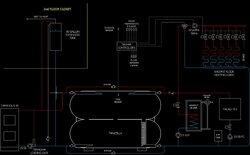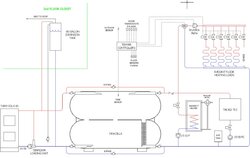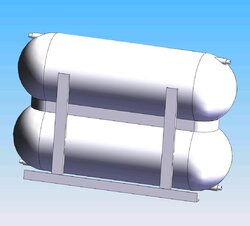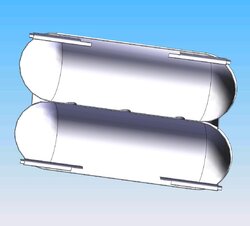I've learned a lot over the last year from members who posted diagrams of their systems (or systems-to-be) and others that commented about various features of the design. Even made a few comments myself.
Now it's my turn.
This is my version of a 'simplest system' with a few different twists. Nothing new over in Northern Europe. The storage tank is a couple 500 gallon propane tanks welded together to make what I referred to in an earlier post as a 1000 gallon hydraulic separator. Code-named "Tankzilla".
It's just a rough schematic sketch, except the heat storage tank itself which is pretty much pictorial. Just the "moving" parts are here that actually have to do with moving hot water when and where it needs to go. The little details that any good hydronics setup would have like air vents, iso valves, and such are not on this drawing. The radiant system's electronic controls are only in enough detail to remind me of how it all works as I think about the actual hydronics.
This layout has sat on my mind about like this for a while and now I ask that if there is something I missed or have configured in a dubious way that you all would be so kind as to point it out to me. Questions about anything that puzzles you are a good way to clarify my thinking so fire away.
Edit: Now that I posted this I'm not so sure I saved this old Autocad sketch properly. Hope you can read it.
Here's a white background version that may be easier to read but the red hot water and blue cold water are color reversed. I'm going to work on fixing that.
Now it's my turn.
This is my version of a 'simplest system' with a few different twists. Nothing new over in Northern Europe. The storage tank is a couple 500 gallon propane tanks welded together to make what I referred to in an earlier post as a 1000 gallon hydraulic separator. Code-named "Tankzilla".
It's just a rough schematic sketch, except the heat storage tank itself which is pretty much pictorial. Just the "moving" parts are here that actually have to do with moving hot water when and where it needs to go. The little details that any good hydronics setup would have like air vents, iso valves, and such are not on this drawing. The radiant system's electronic controls are only in enough detail to remind me of how it all works as I think about the actual hydronics.
This layout has sat on my mind about like this for a while and now I ask that if there is something I missed or have configured in a dubious way that you all would be so kind as to point it out to me. Questions about anything that puzzles you are a good way to clarify my thinking so fire away.
Edit: Now that I posted this I'm not so sure I saved this old Autocad sketch properly. Hope you can read it.
Here's a white background version that may be easier to read but the red hot water and blue cold water are color reversed. I'm going to work on fixing that.





